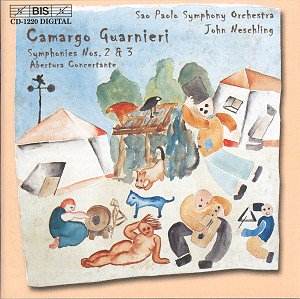On the international stage Brazilian composers have
had their music eclipsed by that of Heitor Villa-Lobos. Guarnieri is
one of those composers who had to live in Villa-Lobos's shadow. He also
carried the handicap of his parent's choice of first name. His full
name was Mozart Camargo Guarnieri. At first he sported his given
first name but in his thirties he decided that it was presumptuous to
use the name 'Mozart' and to all intents and purposes discarded it.
Guarnieri's parents were amateur musicians. Their nine
children included four boys: Mozart, Belline, Rossine and Verdi. Under
the tutelage of the Brazil-based Italian conductor Lamberto Baldi (dedicatee
of Guarnieri's Third Symphony) he made musical progress and had compositions
of his performed in both São Paolo and Rio de Janeiro. In the
1930s he moved to France and there studied under the compositional rigours
of Charles Koechlin. He learnt conducting from François Rühlmann
at the Paris Opera. He was a staunch anti-dodecaphonist.
Expect from Guarnieri the same irrepressible energy
and joie de vivre that you get from Villa-Lobos, Ives and Grainger.
The two half hour symphonies are each in three movements. The Second
Symphony is not afraid of rough energy (tr 1 and 3) which capriciously
fades into reverie as in 3.34 (first movement) with its woodwind reflection.
This work has the vitality of the Americas; the turbulent spirit of
creation, exploration and joy and a jazzy accent in the Festivo
finale. Sometimes, as in the Terno second movement, he draws
on Stravinskian models such as the bleak serenades of the Rite.
This only provides him with a launching point from which to let his
melodic gift loose (tr 2. 2.15). Villa-Lobos's symphonic poem and choral
works bearing the same title (Uirapuru - a reference to an Amazonian
bird) were written before the Guarnieri symphony. The Third Symphony
is less exotically euphoric than the Second and some might say that
the North American influence had unduly diluted and civilised the Brazilian
fantasy and replaced it with the music of the far Western prairies.
Further evidence of this is to be found in the sly and beautifully turned
trumpet solo at 00.31 in the Decidido third movement. The vivo
section of the middle movement is a louche affair with woodwind writing
close to Malcolm Arnold.
The Overture is dedicated to Aaron Copland and
Copland fingerprints are there to be heard as in the placid lullaby
of 4.38 onwards. It is not difficult to see why Guarnieri's music appealed
to Leonard Bernstein. The Fourth Symphony Brasilia (1963) is
dedicated to Bernstein.
There are seven symphonies so presumably, subject to
sales, we will hear more from John Neschling and this orchestra which
was founded almost half a century ago.
Likely to appeal strongly to those who are already
captivated by Villa-Lobos, by Copland (El Salon Mexico and Danzon
Cubano) and by Bernstein's rip-roaring Candide.
Rob Barnett


